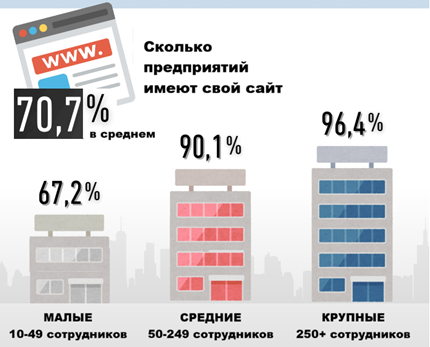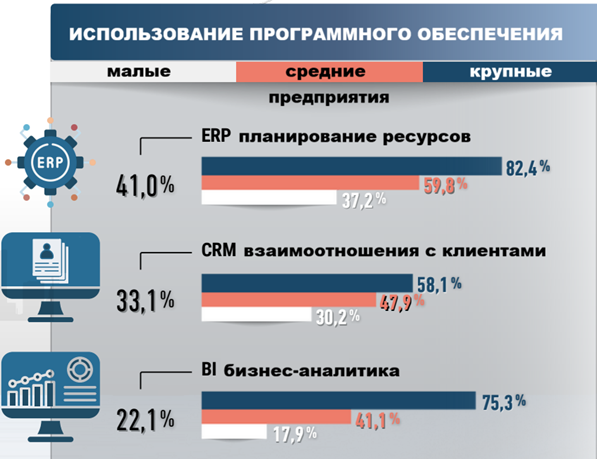На каком этапе цифровизации находится кипрский бизнес сейчас? Данные Статистической службы Кипра за 2025 год показывают, сколько предприятий используют высокоскоростное интернет-соединение, внедряют программное обеспечение для бизнеса и используют искусственный интеллект. Инфографика для наглядности.
Отчет Статистической службы Кипра, посвященный использованию информационно-коммуникационных технологий и электронной коммерции на предприятиях в 2025 году, показал, что 87,3% предприятий на Кипре пользуются высокоскоростным интернет-соединением – со скоростью выше 100 Мбит/с. В 2021 году этот показатель составлял 44,8%.
В 2025 году наиболее используемая скорость загрузки составляла от 100 до 500 Мбит/с (таким соединением располагали 36,5% всех предприятий Кипра). На втором месте по частоте использования оказалась скорость загрузки более 1 Гбит/с (26,2% компаний), за ней – скорость от 500 Мбит/с до 1 Гбит/с (24,6%).

Электронная коммерция
В 2024 году почти каждое четвертое предприятие (23,9%) получало заказы на товары и услуги онлайн, причем 23% компаний – через веб-сайты или приложения и 1,9% – через сообщения типа EDI. 17,1% всех предприятий получали заказы через собственные веб-сайты или приложения, а 14,1% – через веб-сайты или приложения электронной коммерции, используемые несколькими предприятиями. Кроме того, 21,9% предприятий получали таким образом заказы от частных клиентов, в то время как 10% – от других компаний и/или от правительства или государственных органов.


Искусственный интеллект
В 2025 году технологии искусственного интеллекта использовали 9,3% всех предприятий Кипра. В 2021 году таковых было всего 2,6%. По данным Статистической службы Кипра, ИИ используют 35,1% крупных компаний, 15,3% средних и 7,7% малых.
Что понимается под ИИ? Это системы, использующие такие технологии, как:
• интеллектуальный анализ текста,
• компьютерное зрение,
• распознавание речи,
• генерация естественного языка,
• машинное обучение,
• глубокое обучение.
Целью использования является сбор и/или применение данных для прогнозирования, рекомендации или принятия решений о наилучших действиях для достижения конкретных целей.
Внедрение технологий ИИ неуклонно растет на предприятиях всех размеров, отмечает Статистическая служба Кипра. Использование ИИ крупными компаниями выросло с 13% в 2021 году до 35,1% в 2025. Средних предприятий, применяющих его в своей работе также стало гораздо больше: с 5,4% в 2021 году до 15,3% в 2025 году. В малом бизнесе этот показатель вырос с 1,9% до 7,7%.

Какое программное обеспечение используют?
Система планирования ресурсов предприятия (ERP) – наиболее популярное программное обеспечение, используемое предприятиями на Кипре. ERP состоит из набора программных приложений, которые интегрируют информацию и процессы в рамках различных бизнес-функций (например, бухгалтерский учет, планирование, производство, маркетинг). Программное обеспечение ERP в 2025 году использовали 41% предприятий.
Второй по популярности стала система управления взаимоотношениями с клиентами (CRM). Под ней понимается любое программное обеспечение, используемое для управления информацией о клиентах. CRM-системы собирают информацию о клиентах из различных источников, интегрируют ее в единую базу данных, обрабатывают и анализируют информацию, связанную с клиентами. 33,1% всех предприятий на Кипре используют CRM-системы.
Третье по популярности программное обеспечение – это системы бизнес-аналитики (BI). Они обеспечивают доступ к данным из внутренних ИТ-систем и внешних источников, их анализ и представление аналитических результатов в виде отчетов (сводок, графиков, диаграмм и т. д.), предоставляя пользователям подробную информацию для принятия решений и стратегического планирования. 22,1% всех предприятий используют BI-системы.
Согласно результатам опроса, существует связь между размером предприятия и вероятностью использования им бизнес-ПО, такого как ERP, CRM или BI. Малые предприятия, реже используют эти инструменты, чем крупные.
Статистическая служба Кипра отметила, что 33,7% всех предприятий заявили, что их сотрудники выполняют аналитику данных из любых источников, как внутренних (из собственных информационных систем предприятий, собственных веб-сайтов или социальных сетей), так и внешних (из других предприятий, государственных органов или общедоступных данных с веб-сайтов или социальных сетей). Кроме того, 16% предприятий предпочитают нанимать поставщика услуг для проведения аналитики данных, а не делать это самостоятельно.

Предприятия, использующие экологически безопасные процессы
Также отмечается, что 25,4% всех предприятий используют ИТ-системы или решения для снижения энергопотребления, а 22,3% используют ИТ-системы для сокращения расхода материалов или использования переработанных материалов.
68,6% предприятий утилизируют неиспользуемое ИТ-оборудование (например, компьютеры, мониторы) через пункты сбора/переработки электронных отходов, 53,2% оставляют его у себя (для запасных частей), а 32,6% продают, передают в дар или возвращают по лизингу.
Текст подготовлен по материалам Cyprus Business News и CyStat.
Читайте также:
Кипрский парламент окончательно убрал из закона нормы, позволявшие правительству предоставлять гражданство иностранным инвесторам, а также почетное гражданство. Принятые изменения закрывают юридические пробелы после отмены программы «золотых паспортов» и вводят процедуры пересмотра прежних решений, что должно удовлетворить требования Евросоюза.
Согласно закону, принятому 4 декабря на последнем пленарном заседании парламента в этом году, правительство больше не имеет полномочий предоставлять гражданство иностранцам, их супругам и детям в обмен на инвестиции, как это было в период действия программы «золотых паспортов». Сама схема, напомним, была отменена в ноябре 2020 года. Но положения, дающие Совету министров полномочия выдавать кипрские паспорта, оставались в силе.
Правительство также лишилось права выдавать почетное гражданство. Например, детям греческих военных, погибших во время событий 1974 года, или иностранным гражданам, преуспевшим в сфере искусства.
Кроме того, новый закон:
― вводит процедуру пересмотра решений о предоставлении гражданства по ранее действовавшей программе;
― устанавливает срок в 60 дней для обжалования решения о лишении гражданства в специальном Независимом комитете;
― обязывает правительство публиковать имена тех, кого лишили гражданства, в «Официальном правительственном вестнике».
Все эти изменения были сочтены необходимыми ради того, чтобы остановить разбирательство, начатое Евросоюзом против Кипра.
Один из депутатов назвал заседание, на котором были приняты изменения, «панихидой по программе золотых паспортов». Другой парламентарий отметил, что по вине Евросоюза Кипр лишился суверенного права предоставлять почетное гражданство и натурализовывать иностранных граждан.
За прошедшие годы по схеме предоставления гражданства за инвестиции кипрский паспорт получили 7329 человек. Из них 3522 человека были собственно инвесторами, остальные – членами их семей.
Текст подготовлен по материалам Cyprus Mail и «Политис».
Читайте также:
Могут ли демографические изменения повлиять на работу банков или даже создать новые условия в финансовой системе? Наблюдательный совет Европейского центрального банка провел исследование демографической ситуации в странах ЕС и пришел к неутешительным выводам.
Исследование Патрика Монтаньера, члена Наблюдательного совета ЕЦБ, было направлено на то, чтобы признать изменение демографической среды, в которой работают банки, и изучить, как это повлияет на их долгосрочную устойчивость.
«Стареющее население склонно больше сберегать, меньше брать в долг и отдавать предпочтение менее рискованным инвестициям. Меньше молодых семей означает меньше новых жилищных и бизнес-кредитов, в то время как большее количество пенсионеров означает больший спрос на продукты ликвидности и управления активами» – таковы результаты исследования.
По словам члена Наблюдательного совета ЕЦБ, эта трансформация поднимает ряд вопросов: «Насколько стабильным останется местное финансирование, когда пожилые люди будут использовать свои сбережения и другие активы? Как может измениться стоимость залога в регионах, где плотность населения или спрос на жилье снижаются? Могут ли меняющиеся демографические тенденции стать новым источником уязвимости для банковской системы? Все эти вопросы требуют дальнейшего изучения».
Исследование показывает, что во всех странах ЕС, включая Кипр средний уровень рождаемости ниже уровня прироста населения. Опыт Японии позволяет увидеть, к чему может привести старение населения. «Япония давно сталкивается с более напряженным рынком труда, растущими потребностями в уходе и давлением на экономический рост».
Наблюдательный совет ЕЦБ отмечает, что Европа идет не совсем по тому же пути, но столкнется с аналогичными структурными проблемами, поскольку численность ее трудоспособного населения достигнет пика и начнет сокращаться после 2030 года. «Этот сдвиг начался уже десятилетия назад, он постепенный и глубокий. Средний возраст в ЕС уже превышает 44 года, а к 2050 году каждый четвертый европеец будет старше 65 лет».
Патрик Монтаньер объясняет, что «на рынок труда выходит все меньше молодых работников, а рост населения все больше зависит от миграции, как из-за пределов ЕС, так и внутри него, поскольку люди перемещаются в более динамичные городские центры.
Эти потоки поддерживают общий рост, но могут усугубить региональное неравенство, в результате чего сельские и периферийные районы будут сталкиваться с сокращением населения и нехваткой рабочей силы».
Но как эти данные могут повлиять на финансовую систему? Патрик Монтаньер поясняет, что банки, ориентированные на предоставление традиционных услуг, могут столкнуться со структурными проблемами. Сети отделений, оптимизированные для менее продвинутых в цифровых технологиях клиентов, могут испытывать трудности с привлечением молодых клиентов, предпочитающих цифровые каналы.
Некоторые банки, ориентированные на сельские районы, могут столкнуться с давлением. Сейчас они, возможно, и получают стабильное финансирование и высокую краткосрочную прибыль благодаря старению населения, формирующему базу лояльных клиентов. Однако эта клиентская база может сократиться по мере старения старших возрастных групп и миграции молодого населения.
Текст подготовлен по материалам Phileleftheros.
Читайте также:
Процентные ставки растут на фоне снижения чистого объема новых кредитов в октябре. Корпоративное кредитование падает, жилищные кредиты растут, а ставки по депозитам остаются самыми низкими в еврозоне. Центральный банк опубликовал последнюю статистику.
Согласно данным, опубликованным в среду Центральным банком Кипра, чистый объем новых кредитов в октябре по сравнению с сентябрем сократился на 18,5 млн евро, до 429,4 млн евро. Изменение произошло в основном за счет сокращения кредитов компаний, в то время как чистый объем новых жилищных кредитов вырос до 117,5 млн евро.
В то же время, данные показывают, что выросли процентные ставки по новым договорам потребительских кредитов, жилищных кредитов и кредитов компаниям на сумму до 1 млн евро.
Центральный банк Кипра отмечает, что процентные ставки по новым кредитам на Кипре остаются сопоставимыми со средним уровнем, в то время как ставки по новым депозитам находятся на самом низком уровне в еврозоне. Это объясняется высокой ликвидностью кипрских банков, которая в октябре 2025 года составила 329% по сравнению со средним показателем по ЕС в 162%.
Объемы кредитования
Что касается основных категорий новых кредитов, ЦБ сообщает, что чистый объем новых потребительских кредитов увеличился до 23,7 млн евро по сравнению с 21,2 млн евро в предыдущем месяце. Чистый объем новых жилищных кредитов вырос до 117,5 млн евро по сравнению со 112,9 млн евро в предыдущем месяце.
Чистый объем новых кредитов нефинансовым корпорациям на сумму до 1 млн евро снизился до 50,8 млн евро по сравнению с 62,7 млн евро в предыдущем месяце. Чистый объем новых кредитов нефинансовым корпорациям на сумму свыше 1 млн евро также снизился до 232,0 млн евро по сравнению с 246,7 млн евро в предыдущем месяце.
Ставки по депозитам
По данным ЦБ, процентная ставка по срочным депозитам домохозяйств сроком до одного года снизилась до 1,07% по сравнению с 1,10% в предыдущем месяце. Соответствующая ставка по депозитам нефинансовых корпораций незначительно снизилась до 1,23% по сравнению с 1,24% в предыдущем месяце.
Процентная ставка по потребительским кредитам выросла до 6,88% по сравнению с 6,46% в предыдущем месяце. Процентная ставка по жилищным кредитам выросла до 3,73% по сравнению с 3,63% в предыдущем месяце.
ЦБ отмечает, что ипотечные портфели банков состоят из различных видов жилищных кредитов, таких как кредиты на основное жилье или дома для отдыха, которые имеют разные уровни риска и процентные ставки. Состав этого портфеля меняется из месяца в месяц, что влияет на средневзвешенную процентную ставку – независимо от того, повышают или понижают банки ставки по своим индивидуальным кредитам.
Ставки по кредитам
Центробанк Кипра также сообщает, что процентная ставка по кредитам нефинансовым корпорациям на сумму до 1 млн евро выросла до 4,39% по сравнению с 4,32% в предыдущем месяце. В то же время, процентная ставка по кредитам нефинансовым корпорациям на сумму свыше 1 млн евро снизилась до 3,69% по сравнению с 3,79% в предыдущем месяце.
Центробанк Кипра сообщает, что процентные ставки по непогашенным остаткам кредитов на Кипре остаются близкими к медианным по еврозоне, с маржой в 0,0% для домохозяйств и 0,4% для нефинансовых корпораций.
Процентные ставки по новым кредитам на Кипре в целом соответствуют медианным по еврозоне. Маржа средневзвешенной ставки по новым жилищным кредитам для домохозяйств составляет -0,3% (ниже медианного значения по еврозоне), в то время как маржа для нефинансовых корпораций ограничена 0,1%.
Текст подготовлен по материалам Fast Forward.
Читайте также:
Центральный Банк Кипра ждёт реформа
ЦБ недоволен слишком низкими ставками по депозитам
Спустя 12 лет Правительство Кипра сворачивает субсидии на монтаж солнечных панелей с механизмом чистого измерения. Цель – стимулировать рынок электроэнергии, который начал работать в конкурентных условиях с 1 октября 2025 года.
Программы по субсидированию фотовольтаики действовали с 2013 года и были выгодной формой установки домашних фотоэлектрических систем. Около 85 тысяч домохозяйств уже пользуются солнечными панелями, которые работают по методу чистого измерения. Установленные с помощью субсидий фотоэлектрические системы производят на сегодня более 400 МВт энергии в сутки.
Механизм чистого измерения позволял использовать излишки выработанной собственными панелями энергии, фактически оплачивая лишь сетевые сборы, но не платя за саму электроэнергию. Выгоды были выше, чем у схем по методу чистого расчета (net billing).
Было слишком выгодно
Однако, как сообщили в парламентском комитете по энергетике, развитию торговли, промышленности и туризма, Евросоюз потребовал прекратить поддержку схем чистого измерения, поскольку доля возобновляемых источников в энергобалансе Кипра достигла удовлетворительного уровня. Кроме того, выгодная схема чистого измерения вступила в противоречие с принципами новой конкурентной модели: если большинство потребителей предпочтет ее, это сделает запуск рынка фактически невозможным.
Кипрское управление по регулированию энергетики готовит новый регуляторный пакет: любой потребитель сможет заключить договор с любым поставщиком и продавать излишки энергии через двухлетние контракты или напрямую на рынке. При этом действующие схемы Фонда поддержки возобновляемых источников энергии будут работать только до конца 2025 года – из-за завершения их финансирования по плану восстановления и устойчивости.
Новые субсидии будут, но…
Новые программы субсидирования, которые будут включать обязательное сочетание фотовольтаики и систем хранения энергии, планируется запустить в январе-феврале 2026 года и финансировать из бюджета. Если хранение энергии станет обязательным, стоимость установки для граждан резко возрастет, тогда как размер субсидии в €1500 останется без изменений.
Несмотря на неопределённость, Электрическая компания Кипра сообщает о рекордном росте заявок на установку солнечных панелей в рамках программы «Фотовольтаика для всех».
Текст подготовлен по материалам Stockwatch.
Читайте также:
BLIS Global (Business Life Investment Solutions) is proud to announce the launch of an ambitious international initiative designed to bridge the gap between ten distinct financial and business planning professions. The initiative begins with the BLIS Roadshows—a five-city tour across the Middle East and Cyprus in late 2025 and early 2026—culminating in the flagship BLIS Experience summit in May 2026.
Operating under the philosophy that "We do not compete; we complete each other," BLIS Global aims to bring together over 100 international experts from 25 countries. The goal is to raise public awareness about holistic business planning and strengthen strategic collaborations among SMEs and professionals.
The BLIS Roadshows: Connecting the Region To kickstart this movement, BLIS Global will host a series of exclusive roadshows. These events offer free attendance with limited seating to ensure high-quality networking. The tour dates are confirmed as follows:
Beirut, Lebanon: 15 December 2025
Limassol, Cyprus: 18 December 2025
Abu Dhabi, UAE: 07 January 2026
Dubai, UAE: 09 January 2026
Riyadh, KSA: 13 January 2026
The Main Event: BLIS Experience 2026 Following the regional roadshows, the initiative will converge at the BLIS Experience, taking place 3-5 May 2026 at the St. Raphael Resort in Limassol, Cyprus.
This three-day summit will serve as a hub for strategic partnerships, offering attendees VIP access to global thought leaders. Sponsorship opportunities are currently open for organizations looking to position themselves at the forefront of the financial and business planning world.
About BLIS Global
BLIS Global Solutions provides a structure that unites professionals across the financial and business planning sectors. Led by industry experts Naji A. Haddad and Jade W. Dagher, BLIS focuses on creating an ecosystem where professionals complement rather than compete with one another.
For registration, tickets, and sponsorship inquiries, please visit www.blis-global.com/events or contact Этот адрес электронной почты защищён от спам-ботов. У вас должен быть включен JavaScript для просмотра.
Please check below links for more details.
Три энергетических проекта, касающихся Кипра, внесены в список «Проектов общего интереса» Еврокомиссии. Всего в списке 235 энергетических инициатив ЕС. Только что сдвинувшийся с мертвой точки Great Sea Interconnector и два трубопровода для транспортировки природного газа получат новый толчок.
Европейская комиссия объявила об одобрении 235 новых трансграничных энергетических проектов, которым был присвоен статус проектов общего интереса (PCI) и проектов взаимного интереса (PMI). Строительство выбранных объектов будет иметь право на финансирование в рамках программы Connecting Europe, а также ускоренные процедуры получения разрешений и поддержку со стороны регулирующих органов. Это должно ускорить реализацию проектов и укрепить европейскую энергетическую систему.
Согласно опубликованному списку, три проекта представляют особую актуальность для Кипра. Первый – это подводный кабель Израиль-Кипр-Греция, известный как GSI – Great Sea Interconnector, который включает две линии электропередачи: Хадера–Кофину между Израилем и Кипром и Кофину–Коракия между Кипром и Критом.
Комиссия отмечает стратегическое значение проекта, поскольку он впервые обеспечит электроснабжение Кипра как от континентальной европейской сети через Грецию, так и от Израиля, что повысит надежность энергосистемы острова и позволит более широко интегрировать возобновляемые источники энергии.
Во-вторых, в приоритет попал проект Prinos Apollo CO₂. Он предусматривает сбор и хранение углерода на территории морской зоны Принос, и будет включать поставки углерода из Греции, Кипра, Болгарии, Хорватии, Италии и Словении морским транспортом, способствуя развитию регионального рынка улавливания и хранения углерода.
В-третьих, сохраняется статус PCI для трубопровода EastMed, который предусматривает транспортировку природного газа с месторождений Восточного Средиземноморья в Грецию через Кипр и Крит и по-прежнему считается проектом, представляющим общеевропейский интерес.
Комиссар по энергетике Дэн Йоргенсен заявил, что энергетическая инфраструктура – это фундамент устойчивой и процветающей Европы. «Для решения современных задач безопасности, конкурентоспособности и декарбонизации Европе необходима надежная и готовая к будущему энергетическая система. Проекты, которые мы решили поддержать, сыграют жизненно важную роль в обеспечении наших граждан и предприятий более чистой, доступной и безопасной энергией», – отметил он.
На европейском уровне новый список включает 113 проектов в области электроэнергетики, морских и наземных сетей, которые будут иметь решающее значение для интеграции растущей доли возобновляемых источников энергии. Кроме того, в него включены 100 проектов по производству водорода и электролизеров, которые вносят значительный вклад в декарбонизацию энергосистемы ЕС, а также 17 проектов по транспортировке CO₂ для поддержки формирующегося рынка улавливания и хранения углерода, и три проекта по созданию сетей природного газа. Два давно существующих проекта, соединяющих Кипр и Мальту с европейской газовой сетью, также остаются в списке.
Согласно недавнему исследованию, ожидается, что инвестиционные потребности в европейской энергетической инфраструктуре – сетях электроснабжения, водородной энергетики и энергетики на углероде – достигнут 1,5 триллиона евро в период с 2024 по 2040 год, и текущий пакет мер представляет собой важнейший шаг к сокращению этого разрыва. Комиссия отмечает, что современная и интегрированная энергетическая сеть имеет решающее значение для перехода к чистой энергетике и поддержания доступных цен для домохозяйств и предприятий.
Представленный Комиссией пакет мер имеет следующие цели:
- Во-первых, централизованное планирование межсетевых соединений Комиссией, заменяющее текущий подход «снизу вверх», который привел к задержкам и несогласованности действий между государствами-членами, как в случае с кипрским GSI.
- Во-вторых, радикальное упрощение процедур выдачи разрешений, которые сегодня задерживают реализацию проектов на десятилетия из-за бюрократии и местного сопротивления заинтересованных лиц.
- В-третьих, совместное финансирование между государствами-членами, обеспечивающее справедливое распределение затрат на проекты, которые приносят пользу всему континенту, но не обязательно каждой стране в равной степени.
Текст подготовлен по материалам Fast Forward.
Читайте также:
Obtaining the MiCA license is a major turning point for Collect&Exchange CY and the entire cryptocurrency sector in Cyprus. Registration as a Crypto Asset Service Provider (CASP), under the supervision of CySEC, strengthens the company's reputation and brings its activities into a legal and transparent framework – in accordance with strict EU standards.
Why is this important?
With the adoption of MiCAR (Markets in Crypto Assets Regulation) Europe is moving toward a single, regulated crypto asset market, and Cyprus is becoming one of the hubs of this movement. According to CMS Expert Guide, MiCA provides strict rules for CASPs – from KYC / AML controls to capital requirements and internal controls.
CySEC, as the national regulator, has already published a notice that MiCA will officially apply to crypto companies in Cyprus from December 30, 2024.
This regulation strengthens user and investor confidence: licensed companies are required to comply with security, reporting, and customer protection requirements.
Benefits of Collect&Exchange CY
“We are proud to be one of the first companies in Cyprus officially authorised under the MiCA Regulation,” says Ivelina Shapratilska, the company's compliance officer and MLRO, said, "This is an important step for the Cypriot fintech market. We're seeing growing interest from the local community, and now Collect&Exchange CY is ready to strengthen its role in building a transparent and secure digital financial ecosystem."
The company has received the official right to provide such key services as:
- Custody and administration of crypto assets;
- Exchange cryptocurrencies for fiat and vice versa;
- Exchange cryptocurrencies for other cryptocurrencies;
- Transfers of crypto assets on behalf of clients.
Now businesses and individuals in Cyprus can use a fully regulated web application, minimizing risks and ensuring maximum transparency.
Context Analysis: Regulation in Cyprus
Cyprus is creating an attractive environment for crypto businesses: the country has long demonstrated its willingness to play a leading role in the European fintech industry. The national distributed ledger technology (DLT) strategy already includes plans for the development of blockchain technologies, and the government supports innovative crypto projects.
At the same time, there is a balance between innovation and risk: in February 2025, the Central Bank of Cyprus (CBC) urged caution when investing in crypto assets. The regulator emphasizes the volatility of assets and the need for strict anti-money laundering (AML) controls.
On the other hand, CySEC has recently adopted a number of several ESMA guidelines under MiCA regarding asset transfers, reverse offer Solicitation and portfolio management. These measures further enhance investor protection and structure the market, making licensed CASPs more reliable participants in the ecosystem.
Conclusion: Why choose Collect&Exchange CY?
There are several very good reasons why you should choose Collect&Exchange CY will save you a lot of time, money, and, most importantly, nerves when working with digital currencies.
1) MiCA license from CySEC – a guarantee that the company operates under strict EU guidelines
2) A full range of services: from custody to exchange and transfers – everything local, but with a European level of reliability.
3) Trust and security: Regulated status reduces the risks associated with fraud and opacity.
4) Local and international reach: a Cypriot company, but with the possibility of scaling within the EU.
Ultimately, for businesses and individuals interested in a serious, legal, and secure approach to digital assets, Collect&Exchange CY is becoming an excellent choice. If these services are important to you in Cyprus, don't hesitate to contact the company's specialists and forget about problems with digital currency transactions:
Also recently at Collect&Exchange CY has released user-friendly mobile apps for iOS and Android, making any cryptocurrency transactions even faster and more convenient:
iOS
Android
Material are provided by Collect&Exchange CY.
В новом отчете Евростата по жилью в ЕС указывается, что на Кипре достаточно жилых единиц, но арендная плата и стоимость обогрева и кондиционирования сильно завышены. Что влияет на качество жилья на острове, как справляются местные жители, и какие тенденции в строительном секторе.
Для многих домохозяйств на Кипре аренда – главная статья расходов. В период с 2015 по 2024 год арендная плата выросла почти на 25%, что значительно выше среднего показателя по ЕС (около 17%), при этом цены на покупку жилья оставались относительно стабильными.
Такая картина вырисовывается на основании свежих данных Евростата, который выпустил новый отчет «Жилье в Европе» за 2025 год. В отчете рассматриваются типы жилья, формы собственности, площадь, качество, воздействие на окружающую среду и стоимость, а также анализируются тенденции в строительном секторе.
Строительство
В ЕС стоимость строительства новых жилых зданий выросла на 22,7% по сравнению с 2021 годом. На Кипре за тот же период стоимость выросла на 15%, что подчеркивает взаимосвязанность факторов, формирующих рынок жилья. Примечательно, что в 2024 году Кипр инвестировал в жилищное строительство сумму, эквивалентную 8% ВВП, – больше, чем любая другая страна ЕС. Это связано с быстро растущей потребностью в предложении, поскольку по данным на 2023 год население Кипра увеличилось почти на 15% за десятилетие.
Качество жилья
Киприоты живут в сравнительно просторных домах. Среднее количество комнат на человека в ЕС составляет 1,7, а на Кипре – 2, что близко к верхней границе шкалы. Большинство киприотов живут в домах (69,4%), а не в квартирах (30,6%), хотя в городах больше квартир (33,2%), а в сельской местности преобладают дома (93,4%). Однако у этого изобилия пространства есть одна особенность: 70% домов недозаселены, в основном потому, что пожилые люди и семейные пары остаются в своих домах после того, как их дети съехали.
Однако простор не всегда означает комфорт. Почти каждое седьмое домохозяйство на Кипре не может поддерживать достаточное тепло в своих домах, что почти вдвое превышает средний показатель по ЕС. Это тесно связано с высокими ценами на электроэнергию на острове.
Исследование, проведенное Центром экономических исследований Университета Кипра, показало, что рост цен на нефть на 1% приводит к увеличению инфляции в сфере энергоносителей на 3,5%. Поскольку около 80% электроэнергии острова производится из нефти, колебания мировых цен быстро отражаются на счетах домохозяйств.
Хотя в первой половине 2025 года цены на электроэнергию снизились на 9,5% по сравнению с предыдущим годом, в реальном выражении киприоты по-прежнему платят за нее одни из самых высоких цен в ЕС.
Доступность жилья
Тем не менее, доступность жилья на Кипре лучше, чем в целом по ЕС. Доля домохозяйств, тратящих на жилье более 40% своего располагаемого дохода, является одной из самых низких в Европе. Только 2,6% городских и 1% сельских домохозяйств Кипра сталкиваются с такой крайней нуждой. В странах ЕС бремя гораздо выше: 10% городских домохозяйств и 6% сельских домохозяйств.
Даже среди домохозяйств, находящихся на грани бедности, кипрские домохозяйства живут сравнительно неплохо, поскольку менее одной пятой семьи с низким доходом испытывают трудности с оплатой жилья. В странах ЕС этот каждая третья семья на грани бедности затрудняется с оплатой аренды.
Общая картина неоднозначна: рост арендной платы и стоимости строительства контрастирует с в целом стабильной доступностью жилья, просторными домами и постоянно высокими ценами на электроэнергию. Это наглядная иллюстрация парадокса, определяющего современную ситуацию с жильем на Кипре.
Текст подготовлен по материалам Cyprus Business News.
Читайте также:
Кажется, что Кипр бурно развивается. Повсюду строительные краны, многочисленные новые здания возводятся во всех городах. Однако обычные люди, и местные, и иностранцы, не могут найти себе жилье по доступной цене. Что именно идет не так?
По данным компании Ask.Wire, с 2021 года население острова выросло на 70–80 тысяч человек, и страна фактически превысила отметку в 1 миллион жителей. К этому можно добавить 175 000 легальных иностранных работников, которые обеспечивают работу гостиниц, ресторанов, стройплощадок и технологических компаний. Всем им нужно обычное жилье, а не пентхаусы класса люкс.
Да, сфера строительства растет. Но строят в основном не то, что нужно.
Большая часть нового фонда – это премиальное жилье: огромные террасы, вид на море, отделка из итальянского мрамора. Объекты по таким ценам недоступны большинству местных жителей. Даже многие иностранцы не могут позволить себе аренду, не говоря уже о покупке. Людям нужны небольшие, практичные, удобно расположенные квартиры – жилье для жизни. Но вместо этого создается «инвестиционный продукт».
Фактор краткосрочной аренды
Туризм восстановился очень быстро. В прошлом году Кипр принял 3,9 миллиона туристов – почти рекордный доковидный уровень. При этом новые гостиницы практически не строятся, а существующие заполнены – система работает на пределе. Куда же селятся туристы? В объекты, сдающиеся в краткосрочную аренду.
Сегодня на рынке около 16 000 объектов краткосрочной аренды, однако зарегистрировано лишь примерно 8 000. Именно такие квартиры — одно- и двухспальные — пользуются наибольшим спросом. И снова оказываются вне доступа для местных жителей.
Вывод очевиден. Проблема Кипра – не в нехватке строительства. Проблема в том, что строится не то жилье, которое действительно нужно людям, живущим здесь.